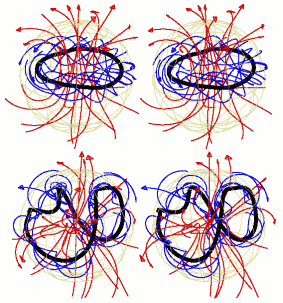|
|
 |
This discovery is important for three groups of stars on which strong
magnetic fields are observed: the so-called magnetic `Ap' stars, the
magnetic white dwarfs, and the `magnetars'. Unlike the magnetic field
observed on the surface of the Sun, which is weak, small-scale and
continuously fluctuating, the field observed on these stars is
large-scale, strong, and static.
Since the discovery of magnetic stars over half a century ago, there have
been two competing ideas to explain their magnetism: one theory
proposes that the magnetic field is generated by a convective dynamo
process operating in the core of the star. The other, the so-called
fossil-field theory, claims that the field is simply left over from
the formation of the star, having been present in the gas cloud out of
which the star condensed. There is circumstantial evidence in favour
of the fossil-field theory, but the main problem has been the lack of
a known magnetic field configuration which is able to survive for a
sufficiently long time. All configurations considered so far (by
analytic means) are unstable and would decay in a matter of years,
(i.e. very quickly compared to the lifetime of a star). There has to
be a stable configuration, and the field has to have a way to find
it. This special configuration has now been found, using numerical
simulations to follow the evolution of an arbitrary initial field as
it relaxes into a stable state.
The stable field has the shape of a twisted torus, not unlike the
fields used in fusion reactors. It is roughly axisymmetric and the
field on the surface of the star is approximately dipolar, but not
exactly, in agreement with the observations. Its shape and existence
appears to be closely linked to a global property called magnetic
helicity.
With these results there is now a reliable basis for the theory of the
magnetic fields in A-stars, white dwarfs and neutron stars.
J. Braithwaite, H. Spruit
Reference:
J. Braithwaite, PhD thesis, University of Amsterdam, 8. April 2004.
|



